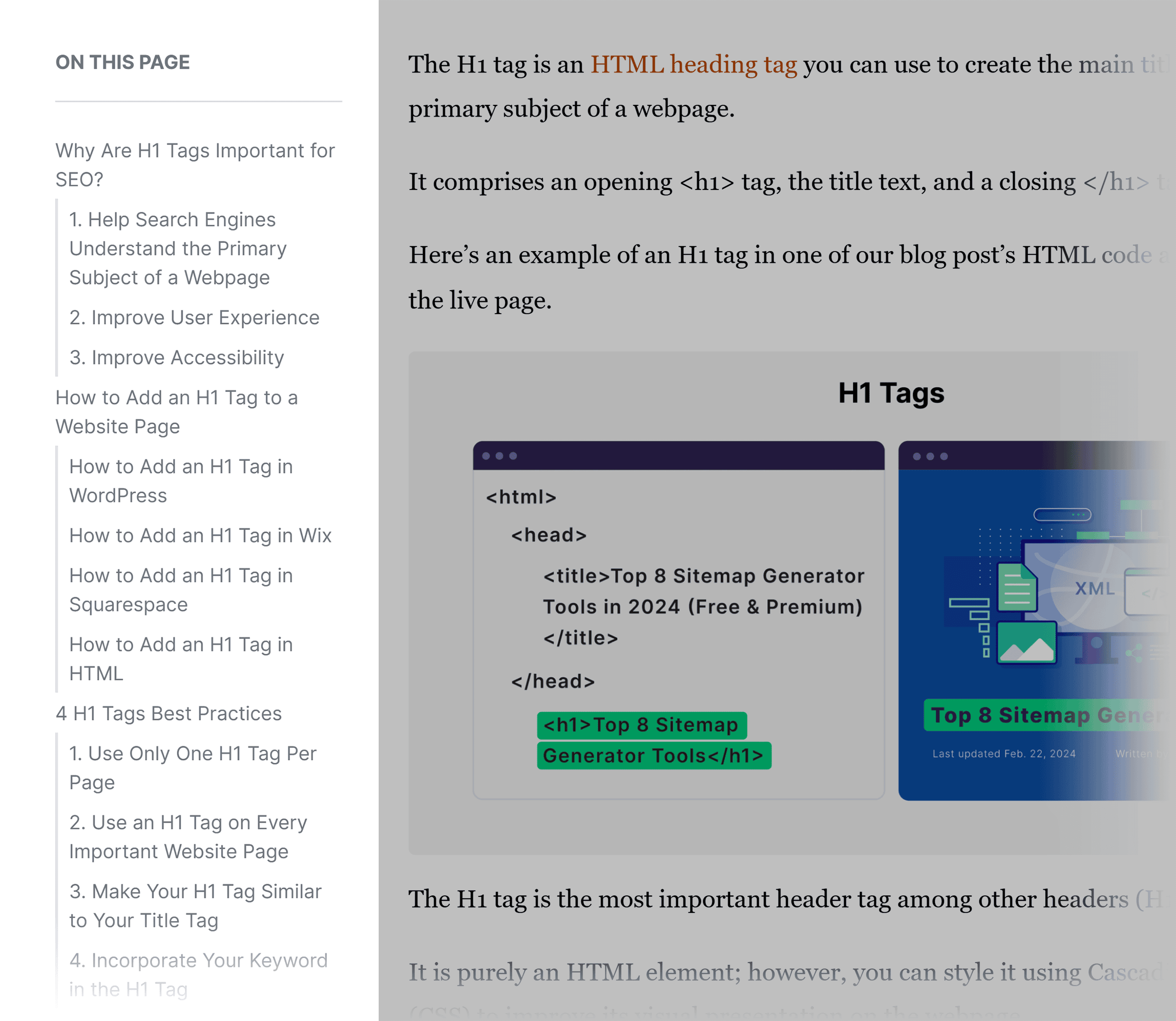Pillar Pages: How to Create One + Examples
Pillar pages are the foundation of an effective search engine optimization (SEO) strategy. At Backlinko, we use pillar pages to secure high search rankings for thousands of keywords. Case in point: Our pillar page for the topic “Link Building...

Pillar pages are the foundation of an effective search engine optimization (SEO) strategy.
At Backlinko, we use pillar pages to secure high search rankings for thousands of keywords.
Case in point:
Our pillar page for the topic “Link Building for SEO.”

This pillar page appears at the top of Google Search results for its target keyword, “link building for SEO.”

As you can see, excellent pillar page content helps boost your website’s visibility on Google.
That’s why creating it should be an integral part of your content marketing strategy.
That’s what you’ll learn about today. We’ll cover:
What pillar pages are How they help with SEO How to create pillar pages, step by step Examples of effective pillar pagesWhat Are Pillar Pages?
Pillar pages—or pillar posts—contain content that comprehensively covers a broad topic. They serve as a central hub that provides an in-depth overview and, importantly, links to more detailed pages known as cluster pages. These cluster pages cover subtopics related to the pillar page.
Together, the pillar page and its cluster pages form a topic cluster. The topic cluster organizes information logically. And guides users through the topic in a structured manner.
Plus, the organization of the topic cluster helps search engines understand the relationship between the different pieces of content. Which should help improve the pages’ search engine rankings.

Pillar pages are always part of a topic cluster. Their power lies in connections to related cluster pages, forming a comprehensive network of interlinked content.
To illustrate:
Let’s say you have a pillar page on “organic gardening.”
The topic cluster’s structure would look like the one below, with the pillar page standing as the “pillar” holding all the pages together.
Topic cluster: Organic gardening Pillar page: “Organic Gardening for Urban Spaces: A Complete guide”(topic cluster primary keyword: “organic gardening”) Cluster pages: “Starting an Organic Garden in Small Spaces”
(topic cluster secondary keyword: “organic garden small spaces”) “Balcony Gardening: Tips for Organic Growth”
(topic cluster secondary keyword: “balcony gardening tips”) “How to Do Natural Pest Control for Urban Gardens”
(topic cluster secondary keyword: “natural pest control urban gardens”)

How Pillar Pages Benefit Your SEO
Pillar pages help boost your SEO rankings in several efficient ways. Here are the top reasons why they’re so effective:
1. They Help Search Engines Find Your Content
Pillar pages link to various related subtopic pages, creating a clear and logical path for search engines to follow.

This interconnected structure helps search engines discover more of your content and understand its context and relevance.
2. They Optimize Link Structure
By linking the pillar page to cluster pages and vice versa, you create a strong network of internal links. This helps users navigate the site. And helps search engines understand which pages are most important.
3. They Target Keywords Efficiently
Pillar pages target the topic cluster’s broader primary keyword. While cluster pages target the topic cluster’s long-tail, secondary keywords. This dual approach helps you rank for both general and specific search terms on a given topic.
4. They Improve the User Experience
Pillar pages offer comprehensive coverage of a topic, providing users with a valuable resource. This keeps users engaged. Reduces bounce rates. And increases dwell time. All of which are positive signals to search engines.
5. They Build Your Topical Authority
By covering a topic in-depth, you signal to search engines that your site is a comprehensive resource. Plus, strategically linking the pillar page and cluster pages, boosts the credibility of all the articles—creating a network of high-quality, authoritative content. This strengthens your site’s topical authority and establishes it as an expert source.
6. They Provide a Chance to Earn Backlinks
Pillar pages—with their comprehensive and valuable content—are prime candidates for earning backlinks. Other websites are more likely to reference and link to these in-depth guides, potentially boosting your overall authority.

How to Create Pillar Pages: A Step-by-Step Guide
Follow these steps to create effective pillar pages.
Step 1: Pick Your Topic Cluster Idea
Begin by selecting a theme for your topic cluster.
Ultimately, you’ll want an idea that aligns with the topics you want your blog to be known for. Piques the interest of your target audience. And is associated with a broad, high-volume keyword that’s relevant to your niche. (More on that in step 2.)
The topic shouldn’t be so broad that it becomes unmanageable. But it should be expansive enough for you to create multiple related pieces of content around it.
We know. It’s a tall order, especially if you’re new to this content creation process.
So where do you get ideas?
Consider:
Topics your audience is already showing interest in Themes your competitors have covered that you haven’t Topics that naturally lead to sales or conversions Topics foundational to your nicheIf you know your niche well, finding topic cluster ideas may come easily.
But, sometimes you might need a little help to get ideas flowing. One way to get great content ideas is by spying on your competitors.
For example, if you have an affiliate niche site that promotes a gardening store, here’s what you can do:
Go to The Spruce website. Look at their gardening and plants section for topic inspiration. You’ll find they cover a variety of topics such as perennials, landscaping, plants, flowers, gardening basics, and shrubs.

These make great topic clusters because they appeal to a wide range of readers. And you can create several related subtopics for cluster pages.
If manually researching for topics feels like too much work, use keyword research tools like Semrush to streamline the process.
Here’s how:
Sign up for a free 14-day Semrush trial.
Navigate to “Content Marketing” > “Topic Research.”

This tool gives you ideas for broad topics that should be perfect for creating topic clusters.
In the search bar, enter a topic related to your blog such as “plants.” And click “Get content Ideas.”

Semrush will provide a list of high-potential topics that are likely to drive traffic to your site. A metric they call “Topic Efficiency.”

Pick any of the broad topics suggested—or create a new search for more topic suggestions—until you find an idea for your topic cluster that you like.
Step 2: Research Keywords to Target
Next step. Identifying the keywords for both the pillar page and the cluster pages.
But first, let’s get something straight.
Before you research specific keywords to target in your content, make sure to prioritize topic cluster ideas that will actually help readers understand the subject better.
While pairing your topic cluster content with keywords that have healthy search volume and achievable keyword difficulty are important, your primary goal should be to improve your readers’ understanding of the covered topic.
A reader-first approach—rather than focusing solely on numbers—will naturally lead you to the right keywords. And ensure your content aligns with what your audience finds valuable.
Given that Google’s recent algorithm updates prioritize helpful content and user experience, this approach is more important than ever.
Pillar Page Keyword
Choosing the keyword for your pillar page is usually straightforward since it’s closely tied to your chosen topic cluster.
The keyword should have a high search volume. And it should offer opportunities for multiple subtopics.
Say your topic cluster is “outdoor plants.”
Start by listing related keywords using tools like Google Keyword Planner, Answer the Public, or Semrush.
On Semrush, you can use the “Keyword Magic Tool” tool.

Enter your broad topic. Then click “Search.”

This will give you a list of keyword ideas and variations.

Look for a keyword with high search volume (indicating popularity) and manageable keyword difficulty (indicating how tough it is to rank for).
For example, the keyword “outdoor plants,” has a search volume of 22.2K and a keyword difficulty of 39, indicating it’s feasible to rank for.

Great. You’ve got a keyword for your pillar page. That was easy, right?
You’re not finished yet.
Now that you have your keyword, you need to decide on the central theme for your pillar page. The central theme will inform the direction of your article. Guides, how-to articles, or ultimate resources are all good options.
Let’s look at some examples.
Here are some pillar page titles targeting the keyword “outdoor plants.” Each represents a different type of pillar page with a unique central theme:
How to Grow Outdoor Plants, Step-by-step Best Outdoor Plants: The Beginner’s Guide Caring for Outdoor Plants: Your Ultimate ResourceEach of these titles targets the keyword “outdoor plants” but approaches it from a different perspective.
Identify the central theme of your pillar page from the get-go. Your cluster page subtopics will depend on it.
Keywords for Cluster Pages
Once you’ve identified your pillar page keyword and its central theme, it’s time to find subtopics and keywords for your cluster pages.
Great cluster page keywords are usually long-tail keywords. They expound on and support the pillar page topic. And are subtopics of the pillar page.
Wondering how to find them? Google is a great starting point.
Go to Google. Enter your pillar page keyword plus its central theme.
Scroll to the “People also ask” section. Here, you’ll find questions related to the topic.

You can also check the “Related searches” section for more keyword ideas.

Use the “People also ask” questions and related searches as inspiration for your cluster page topics.
For example, you might have a list of topics like this:
What’s the easiest plant to grow outdoors Outdoor plants for beginners full sun Small outdoor plants for beginnersThese make great cluster page topics. They’re long-tail keywords with informational search intent. And they support the pillar page topic.
The problem with this process? You don’t know if they’re viable keywords to rank for.
Let’s go to Semrush for that.
Navigate to the “Keyword Overview” tool.

Enter one of your chosen topics, such as “Small outdoor plants for beginners.”

In the window that opens, you’ll see its keyword difficulty (KD) and search volume. This keyword has a KD of 49%, which means it’s possible to rank. However, it has a search volume of 0.

So, what should you do?
Here’s what we say:
You can pick this keyword for your cluster pages.
Even keywords with zero search volume, especially those in Google’s “People also ask” section, can be valuable for a cluster page.
But, if you see a broader keyword you can target, widen your search. And look for related keywords with higher search volume.
For example, instead of “What’s the easiest plant to grow outdoors,” search for “easiest plants to grow outdoors.”

This related long-tail keyword has manageable difficulty. And a search volume of 50.
You might want to target this keyword instead.
This is the type of topic and keyword you’ll want for cluster pages: Long-tail. Supports the pillar page topic. And fits in the topic cluster.
Many get stuck at this point with questions like: What if the keywords don’t have enough search volume? How important is keyword difficulty? Is it more important to focus on how the topic supports the pillar page—and disregard keyword metrics altogether?
Here’s what Backlinko’s Head of Growth, Leigh McKenzie says:
Step 3: Create an Outline That Comprehensively Covers the Topic Cluster
Creating an outline for your article isn’t just about listing headings and subheadings.
You need to structure the entire topic cluster. For comprehensive topic coverage and interlinking.
But before we talk about specifics, let’s recap what you should theoretically have after steps 1 and 2:
A topic cluster: Like, “growing outdoor plants” A pillar page keyword: Like, “outdoor plants” A pillar page title: Like, “Best Outdoor Plants for Beginners: The Ultimate Guide” Cluster page plans, like: Title: “Outdoor Plants That Like Direct Sunlight: Guide for New Gardeners” Keyword: “outdoor plants that like direct sunlight” Title: “Large Outdoor Plants: Top Choices for Your Garden” Keyword: “large outdoor plants” Title: “What Are the Easiest Outdoor Plants to Grow? A Beginner’s Guide” Keyword: “easiest outdoor plants to grow”Have this information ready before you write the outline. It will inform the structure of your pillar page.
Key Points for Creating Your Outline
1. Focus on the Target Keyword
For each page outline, keep the keyword you want to rank for in mind. Structure your outline to naturally incorporate this keyword. This will ensure that the content stays relevant. Focused. And SEO-optimized.
2. Integrate Cluster Page Topics Into the Pillar Page Outline
Include each of the cluster page subtopics in your pillar page outline.
This helps cover the topic comprehensively. And makes it easier to create links between the pillar page and the cluster pages.
3. Make Sure Each Page in the Topic Cluster Can Stand Alone
Structure your outlines so that the pillar page and cluster pages each offer value independently. Every page should thoroughly address its topic. So that readers can understand it without reading the other pages.
Using ChatGPT to Create Your Outline
Now for some good news.
This part of the process is perfect for our friend, ChatGPT. Here’s a prompt you can use:
Create a comprehensive outline for a pillar page based on the following information:
Topic Cluster: [TOPIC] Pillar Page Target Keyword: [KEYWORD] Pillar Page Title: [TITLE] Cluster Page Subtopics: [LIST OF SUBTOPICS]Guidelines for Writing the Outline:
Structure the outline to naturally incorporate the keyword [YOUR KEYWORD] Structure the outline in the context of the topic cluster. And include each subtopic. Make sure the outline includes information on where to add a link to the cluster pages Organize the subtopics in a logical manner
And voila! ChatGPT automatically generates an outline for you.

It’s a solid starting point. All that remains is for you to review and tweak this initial outline to better match your unique insights and specific SEO needs.
Step 4: Write and Design the Pillar Page
When you write your pillar page, focus on creating comprehensive content that is useful for the reader. And make sure to seamlessly incorporate the topic cluster keywords.
To help boost your search rankings, follow SEO best practices as you write.
Here are some SEO writing tips to keep in mind:
Include the keyword in your title. Which should use an H1 tag.

Place the primary keyword early in the article.

Add a table of contents for easy content navigation.

And write high-quality content that offers real value. Solves problems for readers. And answers common questions.
Apart from the content, good design is also integral to pillar pages.
A well-designed page improves user experience. Which encourages readers to stay longer and engage more deeply with the content. It supports the content by making it more accessible and appealing.
Here’s how to use design effectively on your pillar page:
Use visuals to break up text: This helps with readability and illustrating key points.

Format in favor of white space: Ample white space creates a clean, uncluttered look. And makes it easier for readers to read and navigate the content.

Keep blocks of copy short: Break your content into sections with clear subheadings (H2, H3 tags). They guide readers through the content and make it easier to scan.

Step 5: Write the Cluster Page Content and Interlink All the Pages
Now, focus on creating the cluster pages that support your pillar page. One for each secondary keyword.
If you’ve chosen six secondary keywords, you’ll need to draft six cluster page articles.
Now for a very important part of creating cluster pages:
Make sure to link all the pages in the topic cluster. This is imperative. Links are the backbone of your topic cluster.
From the pillar page, link to each of the cluster pages in different sections of the article.
And. On each cluster page, add a link back to the pillar page.
For example, on one of our pillar pages, “Ecommerce SEO: The Definitive Guide,” there’s an internal link to the cluster page, “Shopify SEO: The Complete Beginner’s Guide.”

And if you look at the Shopify SEO cluster page, you’ll see that it also links back to the ecommerce SEO pillar page.

Step 6: Promote and Measure
After all the hard work and time you’ve spent writing the pillar and cluster pages, it’s time to promote the content. And get it in front of your ideal customers.
Use both organic and paid content distribution strategies including:
Email Marketing: Send out a special email or newsletter blurb highlighting the new content Social Media: Share the content across your social media channels Guest Posting: Write guest posts on other sites with links back to your pillar page Targeted Ads: Use targeted social media ads and consider paid promotions through platforms like Google Ads. Or through influencer campaigns.As you roll out this digital marketing strategy, measure the performance of your pillar page and the cluster pages.
Go to Google Search Console (GSC) to track how well these pages are performing.
In GSC explore:
Are the pages ranking for the target search terms? Are they attracting a good amount of organic traffic? Are they getting natural backlinks?Alongside GSC, use tools like Google Analytics to track relevant metrics.
Pay attention to the average engagement time on the page. This indicates how long users stay engaged with your content. A higher engagement time usually means that the content is relevant. And interesting to your audience.
Additional metrics to consider include:
Scroll depth: This shows how far users are scrolling down the page. Which can indicate how engaging they find the content. Links clicked: See if users are exploring the secondary pages linked from your pillar page
Conversions: Track how well your content is driving users to purchase.
Links clicked: See if users are exploring the secondary pages linked from your pillar page
Conversions: Track how well your content is driving users to purchase.
Best Practices for Effective Pillar Pages
These are the elements that help you create an effective and impactful pillar page.
Leave Content Ungated
Make pillar pages fully crawlable by search engines. Don’t require visitors to submit personal information, like their email address, to access the content.
If you want to collect emails, consider adding a content upgrade. Such as a downloadable checklist. This allows visitors to opt-in without gating access to the main content.

Choose a User-Friendly Layout and Design
Poor design can undermine great content.
Make your page user-friendly to keep readers engaged. And make the information easy to digest.
Organize content into clear, distinct sections. And use design elements like headings, bullet points, and short paragraphs to make the text easy to skim.
Add relevant images to complement the text. And include a table of contents to make it easy for users to navigate between different sections of the page.

Add Internal and External Links
Linking is the lifeblood of pillar pages.
Internally, link to all relevant cluster pages within your topic cluster. And make sure these pages link back to the pillar page.
Externally, link to authoritative sites when you reference information that’s relevant to your topic and audience. But not covered on your own site.
This adds value for your readers. And is considered good SEO practice.
Include Strong Call to Actions (CTAs)
CTAs prompt readers to take whatever next step aligns with your marketing goals.
You might invite them to sign up for a newsletter. Read a blog post. Or click through to an affiliate partner.

Place CTAs throughout your content and at the bottom of the page. To encourage further interaction without disrupting the reading experience.

Types of Pillar Pages (+ Examples)
There are several types of pillar pages, each designed to serve a different purpose.
Here are three common types.
1. The Ultimate Guide Pillar Pages
These pages provide an all-encompassing resource on a particular topic. Often covering every aspect of the subject matter.
It is designed to be the go-to resource for readers who want extensive and thorough information. Including in-depth insights, personal experiences, practical tips, and actionable advice.
Take a look at the example below: “Investing: An Introduction” by Investopedia. It’s a thorough guide for beginners to learn about all the major asset classes.
By the end, new investors should have a solid grasp of the different types of investments.

2. How-to Pillar Pages
How-to pillar pages offer step-by-step instructions on how to complete a specific task.
They make sure readers understand the topic thoroughly. And guide them through each step.
Here’s one of our how-to pillar pages. It’s called: “SEO Strategy: How to Create an Effective Plan.”

This pillar page breaks down the strategic SEO process into 10 detailed steps.

3. Resource Pillar Pages
Resource pillar pages act as a central hub with links to various pages that cover a given topic—including articles, tools, and reference material.
These pages are valuable for users looking for consolidated information and tools. In a single, easy-to-navigate location.
An example is our “Best Free SEO Tools” blog article, which lists 41 SEO tools.

Drive More Traffic to Your Pillar Pages
Publishing robust pillar pages and a comprehensive collection of supporting cluster pages is a great way to build site authority. Get recognized for high-quality content. And improve your SEO for better rankings in organic search.
But that’s only the beginning.
Once your topic clusters are live, you’ll want to make sure they’re following all applicable SEO best practices. That way, they’re more likely to rank well on Google Search. And attract a bigger audience to your site.
Get started with our complete on-page SEO guide. It’s full of tips you can apply immediately to boost the quality of your pillar and cluster pages.

 AbJimroe
AbJimroe 
































